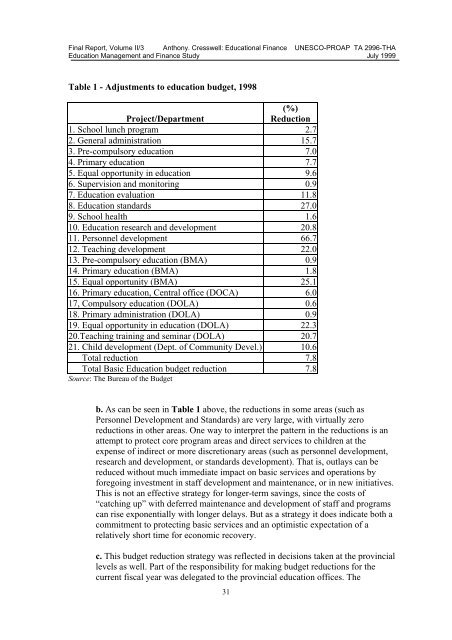Educational Finance in Thailand - UNESCO Bangkok
Educational Finance in Thailand - UNESCO Bangkok
Educational Finance in Thailand - UNESCO Bangkok
You also want an ePaper? Increase the reach of your titles
YUMPU automatically turns print PDFs into web optimized ePapers that Google loves.
F<strong>in</strong>al Report, Volume II/3 Anthony. Cresswell: <strong>Educational</strong> <strong>F<strong>in</strong>ance</strong> <strong>UNESCO</strong>-PROAP TA 2996-THA<br />
Education Management and <strong>F<strong>in</strong>ance</strong> Study July 1999<br />
Table 1 - Adjustments to education budget, 1998<br />
(%)<br />
Project/Department<br />
Reduction<br />
1. School lunch program 2.7<br />
2. General adm<strong>in</strong>istration 15.7<br />
3. Pre-compulsory education 7.0<br />
4. Primary education 7.7<br />
5. Equal opportunity <strong>in</strong> education 9.6<br />
6. Supervision and monitor<strong>in</strong>g 0.9<br />
7. Education evaluation 11.8<br />
8. Education standards 27.0<br />
9. School health 1.6<br />
10. Education research and development 20.8<br />
11. Personnel development 66.7<br />
12. Teach<strong>in</strong>g development 22.0<br />
13. Pre-compulsory education (BMA) 0.9<br />
14. Primary education (BMA) 1.8<br />
15. Equal opportunity (BMA) 25.1<br />
16. Primary education, Central office (DOCA) 6.0<br />
17, Compulsory education (DOLA) 0.6<br />
18. Primary adm<strong>in</strong>istration (DOLA) 0.9<br />
19. Equal opportunity <strong>in</strong> education (DOLA) 22.3<br />
20.Teach<strong>in</strong>g tra<strong>in</strong><strong>in</strong>g and sem<strong>in</strong>ar (DOLA) 20.7<br />
21. Child development (Dept. of Community Devel.) 10.6<br />
Total reduction 7.8<br />
Total Basic Education budget reduction 7.8<br />
Source: The Bureau of the Budget<br />
b. As can be seen <strong>in</strong> Table 1 above, the reductions <strong>in</strong> some areas (such as<br />
Personnel Development and Standards) are very large, with virtually zero<br />
reductions <strong>in</strong> other areas. One way to <strong>in</strong>terpret the pattern <strong>in</strong> the reductions is an<br />
attempt to protect core program areas and direct services to children at the<br />
expense of <strong>in</strong>direct or more discretionary areas (such as personnel development,<br />
research and development, or standards development). That is, outlays can be<br />
reduced without much immediate impact on basic services and operations by<br />
forego<strong>in</strong>g <strong>in</strong>vestment <strong>in</strong> staff development and ma<strong>in</strong>tenance, or <strong>in</strong> new <strong>in</strong>itiatives.<br />
This is not an effective strategy for longer-term sav<strong>in</strong>gs, s<strong>in</strong>ce the costs of<br />
“catch<strong>in</strong>g up” with deferred ma<strong>in</strong>tenance and development of staff and programs<br />
can rise exponentially with longer delays. But as a strategy it does <strong>in</strong>dicate both a<br />
commitment to protect<strong>in</strong>g basic services and an optimistic expectation of a<br />
relatively short time for economic recovery.<br />
c. This budget reduction strategy was reflected <strong>in</strong> decisions taken at the prov<strong>in</strong>cial<br />
levels as well. Part of the responsibility for mak<strong>in</strong>g budget reductions for the<br />
current fiscal year was delegated to the prov<strong>in</strong>cial education offices. The<br />
31

















